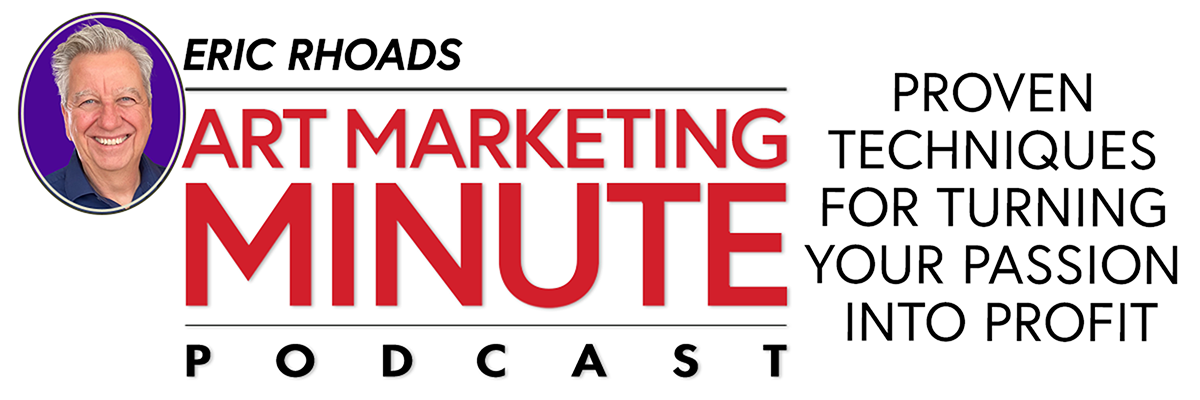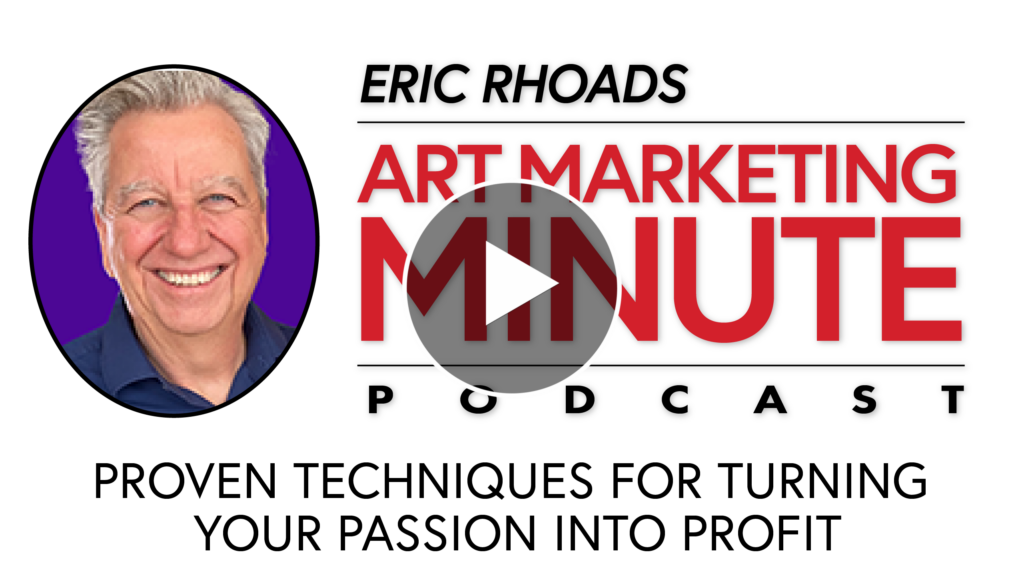In the Art Marketing Minute Podcast, you’ll learn how to sell your art, how to market your paintings, and everything else you need to know in order to have a successful art career. Each episode answers questions from artists by host Eric Rhoads, author of “Make More Money Selling Your Art,” publisher of several art magazines and newsletters, and author of ArtMarketing.com.
Is it better to have a strategy versus a tactic when it comes to selling art? And is it okay to approach multiple galleries for representation? Eric Rhoads answers in this episode of the Art Marketing Minute Podcast.
Listen to the Art Marketing Minute Podcast: Episode 73 >
Submit Your Art Marketing Question:
What questions do you have about selling your art? Email Eric today at [email protected] (include your name and where you’re from) to hear your question answered on an upcoming Art Marketing Minute Podcast.
FULL TRANSCRIPT of the Art Marketing Minute:
DISCLAIMER: The following is the output of a transcription from an audio recording of the Art Marketing Minute. Although the transcription is mostly correct, in some cases it is slightly inaccurate due to the recording and/or software transcription.
Announcer:
This is the Art Marketing Minute with Eric Rhoads, author of the Amazon best selling book, “Make More Money Selling Your Art.” In the marketing minute we answer your questions to help your art career brought to you by artmarketing.com, the place to go to learn more about marketing. Now, here’s your host, arts magazine publisher, Eric Rhoads.
Eric Rhoads:
Thank you and in the marketing minute I answer your art marketing questions you can email yours to me [email protected] By the way, that’s a great resource with lots of marketing content. just go to artmarketing.com. But you can find me there if you want to send in a question. This is a question from Grant Handkola. of Little Rock, Arkansas, who says I’ve heard you talk about strategy versus tactic. Can you speak to that in regards to selling my art? Is it better to have a strategy or a tactic? If I’m a beginner? Well, Grant, it’s both. Everybody needs both. You see, let me see if I can explain this for you. A strategy is how you present yourself and what your meaning is. Now let me use a different brand something it’s not our Walmart, what is Walmart’s strategy, Walmart’s strategy is you know behind the scenes, their strategy is probably selling a lot of volume meaning selling tons and tons of stuff because their strategy says they are always the lowest price as always right. So we know that the Walmart strategy is lowest prices. The tactic is something you do to reinforce what your strategy is like advertising. So you need to know how you’re going to present yourself What is the meaning of grant Hank law as an artist, right. So it might be let’s think about some painters that we know. Joseph, Miguel is one of you know, does some of the most incredible landscape paintings on earth or, or john Snowbird is known as a historic sailboat painter, or Chris blossom is known as a sailboat painter. That’s kind of what you want to be known as now, you could be known as a portrait painter, or you could be known as a mural painter or something else. And you might even have a, something you attach to it, you know, like, I’m known as a expensive portrait painter, you know, like Nelson Shanks, dressed in peace. You know, you knew that if you went to Nelson Shanks, you’re going to pay 80, or 100, or $150,000, for a portrait. So that’s part of your, your strategy. And now how you make your strategy happen as you need tactics, and the tactics are things like promotions, and advertising and newsletters, email blasts, those are tactics. So we all need both tactics, without strategy is not sending a consistent message. But when you have those tactics employed, then you need to always reinforce the strategy. So every time you see a Walmart ad, what do they say? lowest prices, always, always lowest prices always. Right? They every ad they do that reinforces that tactic. And so what you really have to do you know, you have to kind of, especially when you’re first starting yourself out, you kind of want to get branded as something. If you don’t get branded as something, then it’s going to confuse the audience. Yeah, I have a lot of painters who say, Well, you know, I do portraits, I do this, I do that. And that’s okay. But the problem is, you’re going to confuse people, so kind of get known for something. You know, Howard Terpening is known for doing paintings of Native Americans and cowboys. And, but if he started doing flower paintings, and early on in his career, you’d be confusing people. So he’s known for that. Now he can do anything he wants now, because he’s big and you can do anything you want when you’re big. But in the beginning, you want to get known for something. So we need those tactics and we need the strategy. You need to decide who you are, what you stand for what your brand stands for.
Now, the next question comes from Ray Adams in Chicago, Illinois. Ray says, I just got into my first gallery and I wonder if it’s okay to approach more galleries or if it’s better to stay loyal to just one Well, I have a lot of answers to that Ray. And let me start out by saying, I think that first off your gallery relationship is really Critical. And the goal of a good gallery relationship is for it to be one that is symbiotic. In other words, you want to be you in the gallery person need to be strategizing about your career. I just gave advice to a gallery to a person today. He’s in a very big, very well known gallery. And he’s only in that one gallery, and his entire income is based on that one gallery. And I said to him, you know, what happens if that go Art Gallery goes out of business. He said, Well, they’re big, they’re not going to go out of business. I said, Well, I’ve seen big galleries go out of business. So what happens? Well, I would have to get another gallery. And then well, it takes time to build up your career, it takes time to get you known to their collectors. So I said, you know, what I would do is I call your gallery and say, Listen, I don’t want all my eggs in one basket, I want to work with you. And I’d like to get into ideally about three galleries that way, I’ve got some balance in case somebody goes under it, I’ve got some, you know, I get spread out regionally, and so on. So call them up and have a discussion and say, Listen, I don’t want to compete with you. But I also want to be in some good galleries, can you recommend somebody that you feel is of the quality that is equal to your gallery, and then let’s work on that together. And then of course, they can make introductions and help you get in, which saves you a lot of time and trouble. But I think, you know, I like to have the idea of having things spread out among three galleries minimum, and you know, you might not be able to give them all a whole lot of work. And they may or may not like that. But ultimately, you’ve got to think about your career, and you got to think about what’s best for you. Because if somebody goes away suddenly, and we’ve watched that happen in bad economies, where I had artists friend who was in five galleries, three of them, three, I went bankrupt. And so what was he to do, you know, he had to get more galleries just in case the other two went under, because they weren’t selling much. So I think just the general thing, Ray is, you want to keep the quality, you want to be in the highest quality gallery you can be in and a lot of that has to do with your reputation, your strategy. It also has to do with how good you are. And sometimes we start out in a weaker gallery and move up to a stronger gallery certainly has been the case for me. So I think that it’s good. You don’t it’s not about being loyal. It’s about being loyal to yourself. And if you if you’re upfront about it, and you say you know listen, Charlie Charlie’s gallery, you know, how many paintings a year are you expecting to sell from me? And how many do you need? And Charlie says, okay, and the number is 12, or 15, or 20, whatever the number is, you say, Okay, I’m going to focus on giving you 12 really good paintings this year, or 20 or whatever. But I need to be able to also get some paintings in gallery be in Gallery See. And you know, maybe I’ll only give them five each or six each, but at least they’re establishing themselves for you. Getting you some collectors and then you’ve got a backup plan in the event something goes wrong. That’s my opinion on galleries.
Well, this has been the art marketing minute with me. Eric Rhoads. My goal in life is to eliminate the idea of starving artists to help your dreams actually come true. So if you want to submit questions, simply email [email protected]. And to learn more about marketing ideas, you can visit Artmarketing.com. Thanks for listening.
How to Submit Your Art Marketing Questions: What questions do you have about selling your art? Email Eric today at [email protected] (include your name and where you’re from) to hear your question answered on an upcoming Art Marketing Minute Podcast.



Leave A Comment